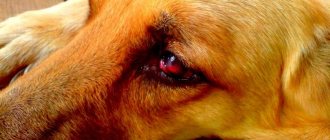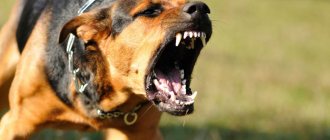A dog’s tongue is not only a muscular organ for recognizing the taste of food, but also an indicator of diseases in its body. It pushes food and liquid into the mouth into the esophagus. This organ is a powerful thermostat. The dog, in order not to overheat in the heat, sticks it out, cooling the body. In addition, dog saliva has a powerful bactericidal effect. And the tongue is a tool for cleansing wounds, abrasions on the surface of the skin and removing dirt and dust. If a dog has a white tongue, then the dog has problems with digestion or other organs.
Why does my tongue turn white?
There are many reasons why your tongue may become discolored or have a white coating on it. This could be anemia, leukemia, gastritis, hypotension, serious blood loss, swelling of internal organs, oncology, lack of food, or lung problems. The cause may be thrush, which manifests itself in young individuals.
You need to check if your pet has other symptoms of disease:
- Heat
- Vomit
- Bloated belly
- Stool disorders
- Discoloration of other mucous membranes
- Smell from the mouth
- Possibly shaking
Gum inflammation in cats
What causes gingivitis?
- Dental disease : Gingivitis is caused by plaque (formed by bacteria and food debris). First, plaque forms on the teeth. Plaque that is not removed from the teeth hardens and becomes tartar. The stone is yellow in color and is visible along the gums at the junction with the teeth.
- Plasmacytic-lymphocytic gingivitis: This is a severe form of gingivitis that causes severe pain, ulcers on the soft palate, oropharynx, and decreased appetite. The reason is still unknown. This disease appears to be associated with an overactive immune response. This type of gingivitis can also be caused by feline calcivirus, rhinotracheitis virus and feline panleukopenia virus.
Symptoms of gingivitis in cats
- bad breath;
- salivation;
- red or swollen gums, especially along the gum line.
- gums bleed, especially when touched;
- lack of appetite.
Establishing diagnosis
Healthy Cat Teeth and Gums
Your veterinarian will examine your cat's mouth, looking for signs of gingivitis, such as tartar, red and inflamed gums, and bad breath.
A biopsy is necessary to diagnose plasmacytic-lymphocytic gingivitis.
Treatment of gingivitis in cats
Treatment depends on the degree of development of the disease. In the early stages of the disease, it can be treated at home with regular teeth cleaning. Treatment may also include tartar removal. In these cases, the gums are treated with special ointments. For example, Metrogyl Denta gel (sold in a human pharmacy), Dentavedin (sold in a veterinary pharmacy), Zubastik, etc.
Even if you think your cat is in good health, a thorough medical can identify problems in the early stages.
Human toothpaste should not be used to clean the teeth of animals!
Treatment of plasmacytic-lymphocytic stomatitis
- regular plaque removal by your veterinarian;
- conscientious dental care for your cat at home in the form of regular teeth cleaning;
- anti-inflammatory drugs such as prednisone;
- interferon and other immunomodulators;
- antibiotics.
If these treatments do not help, the only option is to remove the affected teeth.
Manifestations of gastritis
How to recognize gastritis? The dog is unwell and sometimes has a fever. Taste preferences become non-standard, she loses weight. The tongue is covered with a whitish coating. The wool becomes dull and loses its shine. The pet has frequent belching and vomiting after eating.
What measures should the owner take?
- Be sure to contact a veterinarian.
- Elimination of the inflammatory process in the gastric mucosa with the help of special nutrition and medications (Omez, De-Nol).
If the dog is not treated, the acute disease progresses to the chronic stage. A dog suffering from chronic gastritis loses weight; her metabolic processes are disrupted; She lags behind other pets in growth and development.
Gum recession in dogs. Prevention, treatment
Ivan Makarov, Ph.D. Dr. Sohail Hashemi, DVM, member of EVDS, Department of surgery and dentistry, Iranian pet hospital.
The article uses photographs of the authors
This article is primarily intended for general veterinarians, but it will also help new veterinary dentists better understand some aspects of veterinary periodontology.
Introduction
The most common disease in dogs and cats is periodontitis; more than 80% of animals have this disease. And despite the fact that more and more information is emerging about the need to maintain satisfactory oral hygiene, this percentage is not decreasing. What is this connected with? First of all, despite the awareness of the animal owner, there is no control over the state of the pet’s oral hygiene. Also, despite the prevalence of dental foods, treats, toys, ointments, powders, special liquids and gels that help remove soft plaque from the crown of the tooth, they are used incorrectly. They are prescribed contrary to the recommendations of the annotations and irregularly. And sometimes they continue to use simply ineffective means of combating soft plaque.
Etiology and pathogenesis
How does soft plaque on teeth threaten the health of the oral cavity? Because it causes a number of pathologies, such as gingivitis, stomatitis, periodontitis, and gum recession.
If we simplify the process of development of pathology, it looks like this: an attached substrate is formed on the surface of the tooth, most of the soft plaque is attached in the area of the tooth-gingival border (photo 1, 6, 13), inflammation occurs (gingivitis, stomatitis); further, the inflammatory process leads to the destruction of gum tissue and a violation of the tooth-gingival boundary occurs, a periodontal pocket is formed (photo 7), into which the same soft dental plaque (where the most pathogenic microorganisms are located) gets trapped, which further enhances the inflammatory process and forms more deep periodontal pocket. Then horizontal and vertical bone loss is observed (the alveolar ridge is affected, photo 8). During this phase, tooth mobility and tooth loss are often observed. Periodontitis has a cyclical nature, everything described above refers to the acute phase, and in the remission phase the inflammatory process subsides, so when examining the patient, a mistake can be made in making a diagnosis.
| Photo 1. Cocker spaniel dog, female, 10 years old, gum recession 208 | Photo 2. Cocker spaniel dog, female, 10 years old, gingivoplasty performed |
| Photo 3. Application of orthophosphoric acid to the tooth crown for the purpose of further fixation of the sutures with a composite |
Therefore, during ultrasonic teeth cleaning, it is always recommended to conduct a complete dental x-ray examination of the entire oral cavity. It is also necessary to first perform an instrumental examination, during which a periodontal test is assessed (the result is indicated in millimeters); also, in multi-rooted teeth, the presence of furcation is determined (if this is not visible during examination).
During remission, gum recession is often observed: the gum seems to slide away from its attachment point, part of the tooth root is exposed, and in multi-rooted teeth the presence of furcation is noted (you can see where the roots connect and pass into the neck and crown of the tooth, photo 13). The presence of a furcation sounds like a death sentence; such teeth are removed, since soft plaque will always accumulate under the furcation, which leads to a more severe inflammatory process, but below we will consider treatment options for such teeth.
The above description corresponds to the onset of periodontitis; It is clear that if the stage of remission has already passed and at the time of examination we can see the active stage of the inflammatory process, then in this case, in addition to pronounced inflammation, we will also see gum recession.
Predisposition
The formation of tartar depends on the chemical composition of saliva, the presence of inflammatory processes in the oral cavity, metabolism, the state of internal organs, the nature and composition of food, the length of hair (it often accumulates on the crown part of the tooth), which may be typical for a particular animal, but is important and genetic factor: breed predisposition to periodontitis is most pronounced in decorative breeds of dogs (toy terrier, Yorkshire terrier, toy poodle, etc.).
| Photo 6. Dog, Jack Russell Terrier, 9 years old |
| Photo 7. Periodontal pocket 6 mm |
Diagnostics
As a rule, we receive patients whose pathological process is clearly expressed, and in such a way that even the owner of the animal has no doubt about its presence.
But if we return to those patients in whom it may be somewhat difficult to detect the presence of the same soft plaque at the time of examination, then special chemical dyes or a special lamp will come in handy. Using them, you can identify the localization of the formation of soft plaque and evaluate the quality of oral cavity sanitation (ultrasonic teeth cleaning). However, the extent to which periodontitis has developed in a given patient can only be determined by dental x-ray examination (Figure 8). Bone loss is assessed vertically and horizontally, and then a grade is assigned to the pathological process.
Gum recession can usually be detected during examination of the oral cavity, as well as instrumentally - with a periodontal probe. All of the above manipulations are performed under general anesthesia, since it is not possible to really assess many parameters of the pathological process in our patients without general anesthesia.
| Photo 8. Dental image before osteoplasty (vertical and horizontal bone loss of the alveolar ridge is visualized mesially) |
Treatment
Treatment is usually divided into several stages. In the first stage, ultrasonic teeth cleaning with polishing and dental x-ray examination of the entire oral cavity are carried out, antibiotic therapy, gum treatment, and maintenance of oral hygiene at the proper level are prescribed. After 2 weeks, they begin the next stage, namely, they carry out sanitation of the oral cavity, surgical cleaning of periodontal pockets (closed, open curettage), treatment of the tooth root with special burs and solutions, and gum plastic surgery is also performed. There are several options for forming a gum flap, depending on the degree of the pathological process, the purpose of the tooth, and its anatomical structure. After which the gums are treated, a course of antibiotic therapy and manipulations to maintain oral hygiene are prescribed. Also, due attention is paid to regenerative drugs that promote the restoration of periodontal tissue and bone. Recently, osteoplasty (bone grafting, photo 9) is often used in such patients, which makes it possible to restore lost bone volumes and strengthen teeth, and, accordingly, prevent their removal.
| Photo 9. Osteoplasty, covering the bone with a special membrane |
| Photo 10. Gingivoplasty was performed |
| Photo 11. Dental image after osteoplasty |
Follow-up
Post-treatment examinations are recommended at 3, 7 and 14 days. Next, we examine the patient after a month and, if nothing worries us, we schedule an examination every 3 months.
The owner of the animal must maintain satisfactory oral hygiene - this is the key to the success of the entire treatment. And before we begin, we must have a conversation with the patient’s owners. Moreover, everyone understands that the success of treatment depends not only on the doctor who is treating the patient, but also on the owner, who strictly follows all the doctor’s instructions (the order of treatments, giving antibiotics, brushing teeth, etc.).
We often hear complaints from pet owners that they brush their teeth and follow all instructions, but their pet still develops tartar. Therefore, they believe that all oral care measures are ineffective. However, during questioning, gross mistakes are revealed: for example, they brush their teeth 1-2 times a week, which is not enough, or they take care of the oral cavity before eating food, and not after.
But the doctor should also inform and warn that tartar will form in any case, only much more slowly, and you won’t have to go for ultrasonic teeth cleaning every 6 months, but scheduled visits once every 1.5–2 years will be enough.
For a clearer explanation, we always draw a parallel between a person and a pet. A person brushes his or her teeth 1–2 times every day, and by the age of thirty, many have already visited the periodontist two or more times regarding the formation of tartar and have undergone ultrasonic teeth cleaning. Why then do we expect the opposite from our pets?
| Photo 12. 10 days after surgery, the gums fit tightly, no periodontal pockets were detected |
| Photo 13. Gum recession, periodontitis, furcation 308, 309 visible |
Forecast
The prognosis is usually favorable if the doctor’s prescriptions for improving oral hygiene are followed, and the daily obligatory provision of dental food granules or other treats that have a cleaning effect at the end of the main meal is followed. Periodically giving the animal special bones, toys, sticks for cleaning teeth from soft plaque, regular preventive examination by a veterinarian-dentist - this whole complex will help reduce the formation of soft plaque, and, accordingly, reduce the risk of periodontitis.
SVM No. 5/2019
Rate material
Like Like Congratulations Sympathy Outrageous Funny Thoughtful No words
Tags
Veterinary Periodontics Gingivoplasty Osteoplasty Gum Recession Dog Dentistry
Manifestations of anemia
Anemia in dogs is divided into several types. For example,
- Posthemorrhagic pathology (occurs after major blood loss). Symptoms: pale mucous membranes and tongue, hemorrhages under the pet’s skin.
- Hypoplastic anemia. Characterized by a lack of vitamins, micro- and macroelements in the body. May be caused by toxic damage to the bone marrow.
- Nutritional. Root cause: incorrect, meager, unbalanced pet menu from an early age. Sometimes the reason is a pathology of intestinal absorption.
- Aplastic form. Develops due to impaired hematopoietic function.
Symptoms: the dog has a white or hot tongue, the dog does not get up on its feet very often, does not stand up when called by name, moves less, gets tired quickly, lies a lot. She has poor appetite, her mucous membranes and tongue turn pale and may even turn blue. The gums are cold to the touch upon palpation. There is shortness of breath, abnormal bowel movements, the pet often drinks, and may have a fever. The examination reveals an increase in organs.
Treatment
- Diagnosis using blood, urine, stool, ultrasound of internal organs
- Infusions into veins to increase blood volume
- Transfusion of blood components to an animal
- Bone marrow transfusion
- A course of antibiotics if the root cause of anemia is an infection.
- Taking vitamin K1, drugs with a high content of iron, potassium, etc.
- In difficult cases, operations are performed.
Manifestations of thrush
The symptoms of the disease depend on the source of its damage. When localized in the ears, the pet shakes its head and scratches the itchy areas. When the oral cavity is affected, the animal's salivation increases, and the tongue becomes white and coated. Ulcers may appear on the skin, fever and skin irritation may occur.
How to treat the disease?
The main goal of therapy: to increase immunity by forcing the dog’s body to resist Candida fungus. Antifungal drugs are applied topically to areas affected by the disease (mucous membranes, skin). After the acute manifestations of the disease have subsided, the course of treatment is continued for another 14 days. After therapy, the doctor takes tests for the presence of the pathogen.
Nutrition during treatment
During the period when the dog is being treated for gingivitis, it is necessary to switch it to softer food. This also means excluding bones from the diet. It is better to abstain from rough food: it can further injure the damaged soft tissues of the animal’s oral cavity.
Each feeding of the dog must be completed by disinfecting the gums with a 0.05% chlorhexidine solution.
After the animal is cured, it is necessary to regularly prevent this disease - examine the dog daily. If inflammation of the oral cavity or any abnormalities are detected, you should immediately contact a veterinary clinic.
Manifestations of adenovirus
Adenoviral infection can also cause a white coating on the tongue and mucous membranes. This is a viral disease that affects the respiratory tract and gastrointestinal tract. Clinical picture: the animal’s throat becomes red, it is tormented by a cough, runny nose, the dog wheezes when breathing, and stool disturbance and vomiting are often observed.
The animal moves less and eats poorly.
Treatment:
- Course of antibiotics
- Increasing the body's defenses with medications
- Nasal drops
- Expectorants
If left untreated, the virus will lead to pneumonia and may well lead to the death of your pet.
Stomatitis
Clinical picture of the disease: the appearance of a white coating on the tongue, bad breath from the pet’s mouth. The dog refuses to eat, its jaw trembles, and the lymph nodes in its neck become enlarged.
Many single formations form in the oral cavity, which often merge. The disease affects dogs between 7 and 9 months of age, develops for about 5 months, and then goes away on its own.
The disease is treated with conservative methods and surgical intervention. If single neoplasms are widespread, they are cauterized with electric current or cauterized with liquid nitrogen. When affected by multiple ulcers, immunity is increased and local treatment is used aimed at destroying the causative agent of the disease.
Tumors in the oral cavity
Such neoplasms, as a rule, do not cause any concern in the early stages; the dog feels well, is mobile and active. The main symptom: hot and white tongue, mobility of one or more teeth. If the gums are of normal color and all teeth are healthy, this is a reason to suspect a malignant neoplasm.
It is often confused with stomatitis, because the neoplasm visually resembles a lesion with inflammation. Therefore, for a correct diagnosis, it is better to conduct a histological examination.
As a rule, the prognosis is unfavorable. The life expectancy of dogs with malignant tumors is reduced to a year. It is almost impossible to cure an animal. You can prolong life and temporarily alleviate your pet’s condition with surgery, chemotherapy, and radiotherapy.
Benign tumors are more common in dogs with a flat skull, while malignant tumors are equally common in all breeds. Benign neoplasms make it difficult to drink and eat. The animal refuses to eat and does not take a stick when playing. The owner observes chewing food on one side of the jaw, the animal quickly gets tired, rubs its muzzle against objects, and rubs its muzzle with its paws.
Therapy for benign tumors is aimed at excision of the tumor. During surgery, the tumor is excised along with nearby healthy tissue to prevent recurrence of the disease. If the tumor is benign, then the outcome of the treatment is favorable and the dog continues to live for many years, delighting its owner. It will also be interesting about pemphigus.
Remember that if your pet has a white tongue, you should definitely take her to the veterinarian to diagnose the disease. After all, the cause of plaque or discoloration of this organ can even be cancer or serious pathologies of internal organs.
Currently reading:
- Thyroid dysfunction in dogs (hypothyroidism)
- Seven Signs and Remedies for Getting Rid of Fleas in Dogs
- What to do if your dog has an abnormal bite
- How to recognize signs of dog poisoning from rat poisons
How not to miss a developing disease?
When examining your pet, be sure to wash and disinfect your hands. The dog should be calm, if it breaks out and is afraid, then you need to let it relax a little and take it to the veterinarian - with the help of a professional everything will work out faster. During a basic home examination, there are a number of signs to look for that are likely to indicate that dental or general health problems are present.
- An aggressive or restless reaction to examination that suggests the dog is in pain when touched.
- Refusal of food or only partial intake of it, when the animal just sits over the bowl for a long time.
- Traces of blood on the lips or in a bowl of water may also be on the gums or surrounding fur.
- A putrid odor from the mouth, which appears not only immediately after eating, but at any time.
- Lethargy, the pet’s desire to hide, but it can also be the other way around, when the dog is looking for attention and seems to be trying to put its muzzle into the owner’s hands in search of help.
- High temperature, which indicates the presence of infection in the body.
It is not necessary that all these signs will be present at the same time. They can appear either one at a time or in any sequence. The owner must use his or her own common sense in assessing whether the pet's behavior and condition have changed.
Having noticed that your dog’s gums have turned black, you need to examine them to determine whether there is pain when touched and pressed. If it is not there, then do not be nervous, because most likely this is only a manifestation of the color of the animal, determined genetically. But if you have a restless reaction to examination and refuse to eat, you should definitely go to the veterinarian. When a pet doesn't want to eat, this is one of the most dangerous signs. This is like giving up the fight for your health; here you need to react as quickly as possible.










